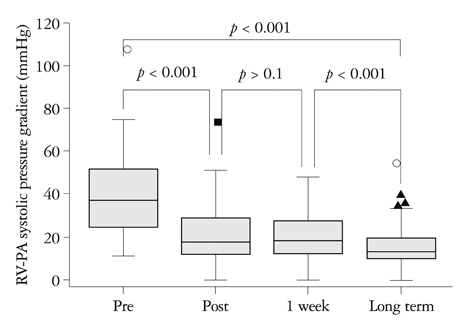J Cardiovasc Ultrasound.
2013 Mar;21(1):18-22. 10.4250/jcu.2013.21.1.18.
The Comparison between the Echocardiographic Data to the Cardiac Catheterization Data on the Diagnosis, Treatment, and Follow-Up in Patients Diagnosed as Pulmonary Valve Stenosis
- Affiliations
-
- 1Division of Pediatric Cardiology, Severance Cardiovascular Hospital, Yonsei University Health System, Seoul, Korea. cjy0122@yuhs.ac
- KMID: 1428372
- DOI: http://doi.org/10.4250/jcu.2013.21.1.18
Abstract
- BACKGROUND
Isolated pulmonary valve stenosis (PS) makes up 6-9% of all congenital heart defects among children. The initial gold standard for diagnosis, follow-up of PS is by echocardiography. However, the most accurate diagnosis still remains to be measurement of the pressure gradient through transcatheterization. The purpose of this study is to compare the difference between the echocardiographic data to the cardiac catheterization data on the diagnosis, treatment, and follow-up in patients diagnosed as PS, and to see what parameters should be closely monitored.
METHODS
A total of 112 patients (Male : Female = 46 : 66) who underwent balloon pulmonary valvuloplasty (BPV) at Severance Cardiovascular Hospital, between December, 2002 to August, 2012 were retrospectively analyzed. The patients were all under 16 years of age and critical PS patients who underwent BPV were excluded from this study.
RESULTS
The pre-BPV right ventricle (RV)-pulmonary artery (PA) systolic pressure gradient and post-BPV systolic pressure gradient showed statistically significant decrease. The pre-BPV RV-PA systolic pressure gradient and 3 month post-BPV systolic pressure gradient showed statistically significant decrease. The consistency between the echocardiographic data and cardiac catheterization data shows statistically significant consistency. The mean pressure gradient and systolic pressure gradient on the echocardiography shows high consistency when comparing with the cardiac catheterization data.
CONCLUSION
Our study shows that BPV in PS is a safe and effective procedure in children and adolescent. The standard echocardiographic evaluation of PS, during diagnosis and follow-up, should include mean transpulmonic pressure gradient, as well as the peak systolic pressure gradient. The success of the procedure should be held off until at least 3 months, only if the patients do not show any symptoms.
Keyword
MeSH Terms
Figure
Reference
-
1. Weryński P, Rudziński A, Król-Jawień W, Kuźma J. Percutaneous balloon valvuloplasty for the treatment of pulmonary valve stenosis in children - a single centre experience. Kardiol Pol. 2009. 67:369–375.2. Hatem DM, Castro I, Haertel JC, Rossi RI, Zielinsky P, Leboute FC, Pomar N, Winckler M, Kersten RN, Cardoso CR, Gottschall CA. [Short- and long-term results of percutaneous balloon valvuloplasty in pulmonary valve stenosis]. Arq Bras Cardiol. 2004. 82:221–227.3. Lababidi Z, Wu JR. Percutaneous balloon pulmonary valvuloplasty. Am J Cardiol. 1983. 52:560–562.
Article4. Radtke W, Keane JF, Fellows KE, Lang P, Lock JE. Percutaneous balloon valvotomy of congenital pulmonary stenosis using oversized balloons. J Am Coll Cardiol. 1986. 8:909–915.
Article5. Rao PS, Fawzy ME, Solymar L, Mardini MK. Long-term results of balloon pulmonary valvuloplasty of valvar pulmonic stenosis. Am Heart J. 1988. 115:1291–1296.
Article6. Fitzgerald KP, Lim MJ. The pulmonary valve. Cardiol Clin. 2011. 29:223–227.
Article7. Mullins CE, Ludomirsky A, O'Laughlin MP, Vick GW 3rd, Murphy DJ Jr, Huhta JC, Nihill MR. Balloon valvuloplasty for pulmonic valve stenosis--two-year follow-up: hemodynamic and Doppler evaluation. Cathet Cardiovasc Diagn. 1988. 14:76–81.
Article8. Zhang Y, Nitter-Hauge S. Determination of the mean pressure gradient in aortic stenosis by Doppler echocardiography. Eur Heart J. 1985. 6:999–1005.
Article9. Shah PM. Tricuspid and pulmonary valve disease evaluation and management. Rev Esp Cardiol. 2010. 63:1349–1365.
Article10. Rao PS. Percutaneous balloon pulmonary valvuloplasty: state of the art. Catheter Cardiovasc Interv. 2007. 69:747–763.
Article11. Gielen H, Daniëls O, van Lier H. Natural history of congenital pulmonary valvar stenosis: an echo and Doppler cardiographic study. Cardiol Young. 1999. 9:129–135.12. Moller I, Wennevold A, Lyngborg KE. The natural history of pulmonary stenosis. Long-term follow-up with serial heart catheterizations. Cardiology. 1973. 58:193–202.13. Sullivan ID, Robinson PJ, Macartney FJ, Taylor JF, Rees PG, Bull C, Deanfield JE. Percutaneous balloon valvuloplasty for pulmonary valve stenosis in infants and children. Br Heart J. 1985. 54:435–441.
Article14. Berman W Jr, Fripp RR, Raisher BD, Yabek SM. Significant pulmonary valve incompetence following oversize balloon pulmonary valveplasty in small infants: a long-term follow-up study. Catheter Cardiovasc Interv. 1999. 48:61–65. discussion 66.
Article15. Otto CM. Valvular aortic stenosis: disease severity and timing of intervention. J Am Coll Cardiol. 2006. 47:2141–2151.16. Holzer RJ, Gauvreau K, Kreutzer J, Trucco SM, Torres A, Shahanavaz S, Bergersen L. Safety and efficacy of balloon pulmonary valvuloplasty: a multicenter experience. Catheter Cardiovasc Interv. 2012. 80:663–672.17. Jarrar M, Betbout F, Farhat MB, Maatouk F, Gamra H, Addad F, Hammami S, Hamda KB. Long-term invasive and noninvasive results of percutaneous balloon pulmonary valvuloplasty in children, adolescents, and adults. Am Heart J. 1999. 138(5 Pt 1):950–954.
Article18. Kaul UA, Singh B, Tyagi S, Bhargava M, Arora R, Khalilullah M. Long-term results after balloon pulmonary valvuloplasty in adults. Am Heart J. 1993. 126:1152–1155.
Article
- Full Text Links
- Actions
-
Cited
- CITED
-
- Close
- Share
- Similar articles
-
- Comparisons of the Pressure Gradients between Two-Dimensional Echocardiographic Doppler Studies and Cardiac Catheterization in Pulmonary Stenosis
- Doppler Echocardiographic Assessment of Diastolic Pressure Gradient and Mitral Valve Area in Mitral Valvular Disease
- Mitral Valve Area and Resistance in Mitral Stenosis: Comparison of Cardiac Catheterization and Doppler Echocardiography
- Indices for Assessing the Dynamic Severity of Mitral Stenosis
- Immediate and Follow-up Results after Percutaneous Mitral Valvuloplasty in Mitral Stenosis


